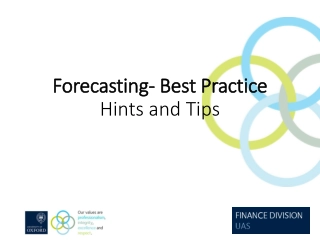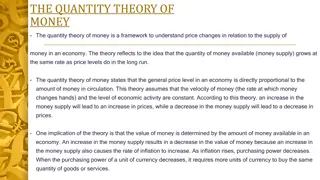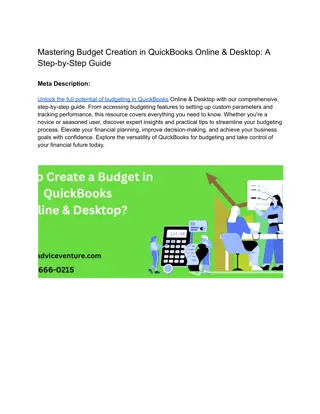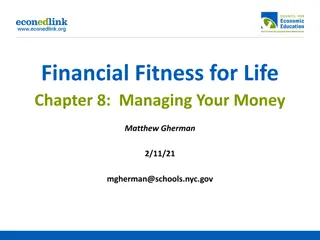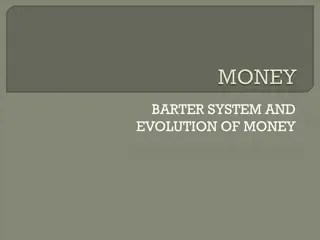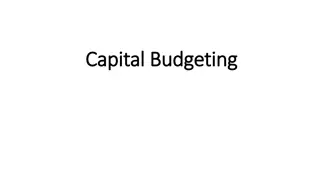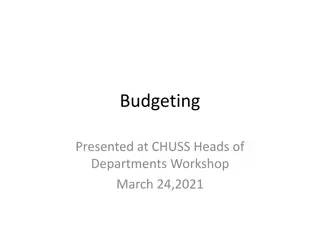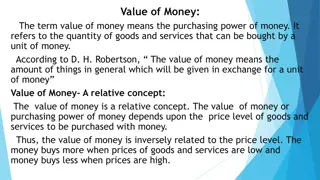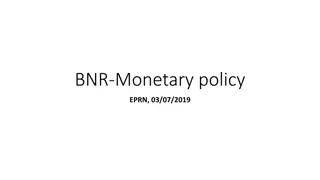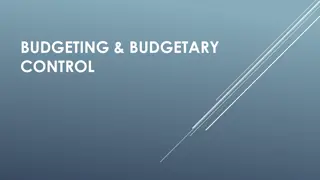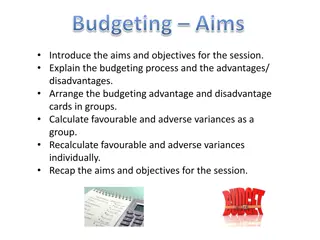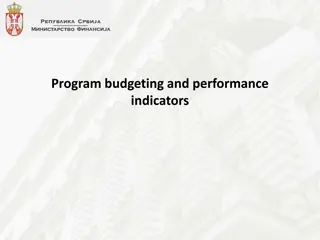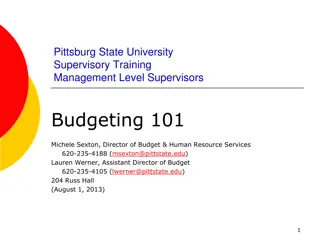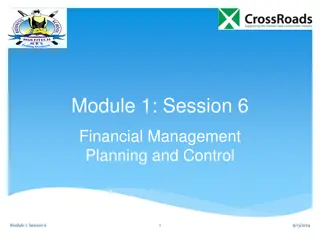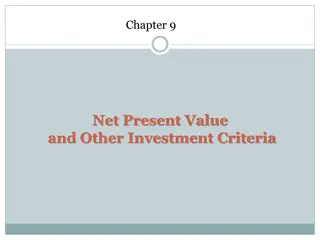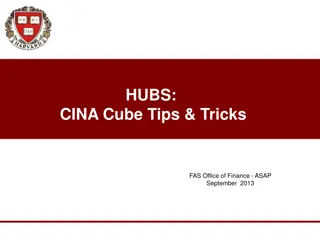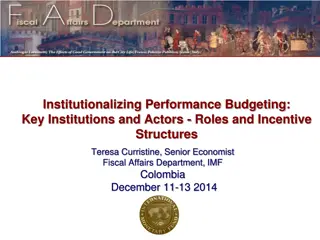Managing Your Money: The Importance of Budgeting
Understanding the financial impact of preparing a budget is crucial for effective money management. Lesson 4: Back to School focuses on teaching students how to create and implement a budget to achieve their financial goals. By explaining budgeting vocabulary, identifying the purpose of a budget, and outlining steps to manage finances, students can gain control over their money, live within their means, and work towards increasing their wealth. This lesson emphasizes the significance of budgeting in helping individuals track income, expenses, and savings effectively.
Download Presentation

Please find below an Image/Link to download the presentation.
The content on the website is provided AS IS for your information and personal use only. It may not be sold, licensed, or shared on other websites without obtaining consent from the author. Download presentation by click this link. If you encounter any issues during the download, it is possible that the publisher has removed the file from their server.
E N D
Presentation Transcript
LESSON 4 BACK TO SCHOOL
LESSON 4: BACK TO SCHOOL LESSON OBJECTIVES STUDENTS WILL: 1.EXPLAIN AND USE THE VOCABULARY ASSOCIATED WITH BUDGETING. 2.IDENTIFY THE PURPOSE OF A BUDGET. 3.IMPLEMENT THE BUDGETING STEPS. 2
Lesson 4: Back to School BACK TOSCHOOL 5
Lesson 4: Back to School ASSESSING THE IMPACT OF FINANCIAL PREPAREDNESS What did Jamie s friends recommend in order to be financially prepared? How was Jamie able to use the money she had earned and saved? How might having a budget help you achieve your financial goals? How might getting a good education help ensure your financial future? 4
Lesson 4: Back to School MANAGING YOUR MONEY: THE BUDGET WHAT IS A BUDGET? A budget is a plan that helps you manage your money by helping you balance your income with your expenses. It is an itemized summary of probable income and expenses for a given period. WHY CREATE A BUDGET? A budget helps you understand where your money goes. It helps you live within your means and meet your goals. It helps you find uses for your money that will increase your wealth. It puts you in control of your money. 6
Lesson 4: Back to School MANAGING YOUR MONEY: THE BUDGET Determine Income Review & Adjust Implement & Track Identify Expenses & Track Spending Develop the Budget Plan 7
Lesson 4: Back to School THE BUDGET: DETERMINE INCOME Calculate your income. Identify all income sources. Wages/salaries Gifts or allowance Interest Scholarships, grants, and student aid Understand the difference between net and gross income. Determine Income 8
Lesson 4: Back to School THE BUDGET: IDENTIFY EXPENSES AND TRACK SPENDING DETERMINING YOUR EXPENSES Consider all expenses. Determine which are fixed and which are variable expenses. EXPENSE CONSIDERATIONS Identify Expenses & Track Spending Know what you owe. Consider your ongoing needs. Plan other expenditures. Identify how much money you need to cover expenses. Expect the unexpected. 9
Lesson 4: Back to School TRACKING YOUR EXPENSES WHERE DID YOUR MONEY GO? Example purchase On what? Where? How much? How paid? A large caramel latte Specialty coffee store $4.75 Cash 10
Lesson 4: Back to School ACTIVITY: TRACKING YOUR EXPENSES TRACK DAILY EXPENSES FOR THE PAST TWO DAYS Item Purchased/ Expense Payment Method Cash, Check, ATM/Debit Card, Credit Card, Autodraft, etc. Fixed or Variable Expense Date Amount 10/1 Car payment $250 Autodraft Fixed 10/1 Gas $40 Debit card Variable 10/2 Car insurance $150 Check Fixed 10/2 Lunch $5 Cash Variable 11
Lesson 4: Back to School ACTIVITY: TRACKING YOUR EXPENSES DEBRIEFING What types of goods and services did you purchase? What types of payment methods did you use? Did the way you paid affect how much you spent? Which expenses were fixed and which were variable? Any surprises regarding how much you spent? What income did you have that paid for these expenses? Did tracking make you rethink any of your purchases? What influenced your spending people, situation, emotion? How did the purchase make you feel? What about now? 12
Lesson 4: Back to School THE BUDGET: DEVELOP THE BUDGET PLAN Information already gathered: Income Fixed and variable expenses Develop the Budget Plan Other considerations: Pay yourself first savings Consider your goals Budget shortfalls 13
Lesson 4: Back to School CREATE A BUDGET How much money do you get each month? Income Income $2,000 What expenses do you have each month? Fixed Expenses Rent Cell Phone Car insurance ($300/quarter) Fixed Expenses $ 600 $ 40 $ 100 Variable Expenses Food (estimate) Utility bills (estimate) Gas Variable Expenses $ 500 $ 50 $ 50 Total Expenses $1,540 14
Lesson 4: Back to School ACTIVITY: BUDGET SCENARIOS In this activity, you will work in groups to allocate $2,000 to a monthly budget estimate. You will then take turns drawing scenario cards to see how close you came to estimating expenses. Once you have drawn all of the cards, answer the questions at the bottom of the worksheet. 15
Lesson 4: Back to School ACTIVITY: BUDGET SCENARIOS Income Net income Estimate Actual $2,000 Fixed Expenses Rent $450 $25 Renter s insurance Automobile loan payment Automobile insurance Medical insurance Student loan Total Fixed Expenses $250 $75 $100 $325 $1,225 Variable Expenses $200 $75 Groceries Dining out Utilities Gasoline Car maintenance Clothing and personal upkeep Gifts Entertainment Savings Total Variable Expenses $125 $75 $75 $25 $100 $10 $75 $760 $1,985 $15 Total Expenses SURPLUS (DEFICIT) 16
Lesson 4: Back to School ACTIVITY: BUDGET SCENARIOS DEBRIEFING How did your group s estimates differ from the scenarios? How much did you estimate as savings each month? Were there expenses on this budget that were not listed in the categories provided? If you had to pay for these expenses, where would the money come from? 17
Lesson 4: Back to School THE BUDGET: IMPLEMENT AND TRACK Implement the budget. Implement & Track Continue to track spending. 18
Lesson 4: Back to School THE BUDGET: REVIEW AND ADJUST Review the budget at least monthly. Review & Adjust Make necessary adjustments for your situation. Consider the following in your review: Have income sources changed? Does your income cover your expenses? Where and when are you spending money? Are you saving regularly? Has anything affected your income, spending, and saving? Are you achieving your personal and financial goals? 19
Lesson 4: Back to School IN SUMMARY Budgeting puts you in control of your money and helps you understand the allocation of your income. 20
Katrinas Classroom was developed by a team of Senior Economic and Financial Education Specialists at the Federal Reserve Bank of Atlanta. Claire Loup, New Orleans Branch Julie Kornegay, Birmingham Branch Jackie Morgan, Nashville Branch For additional classroom resources and professional development opportunities, please visit www. frbatlanta.org/education 21


